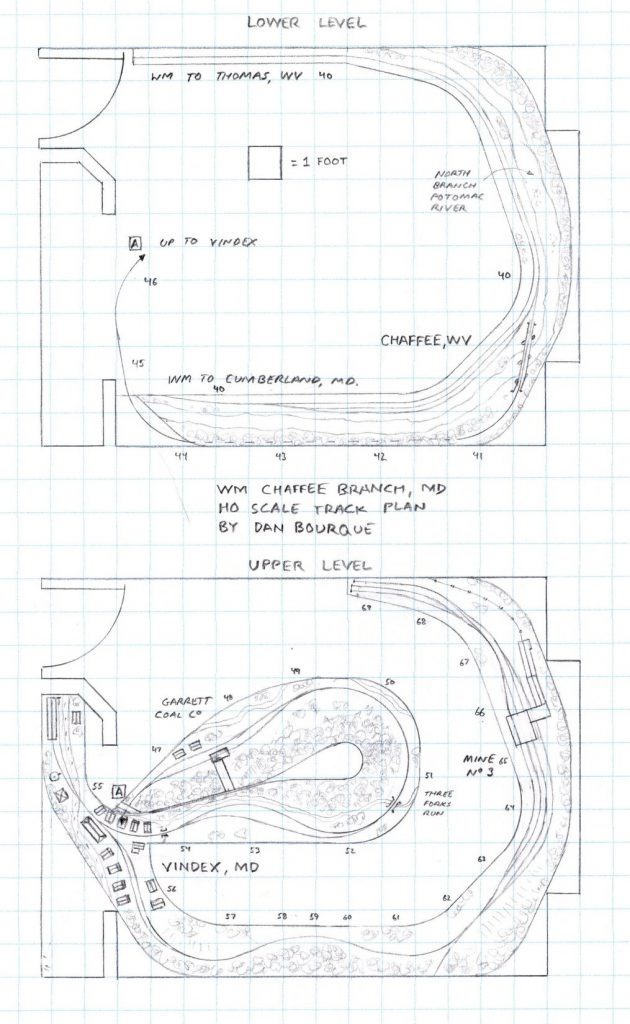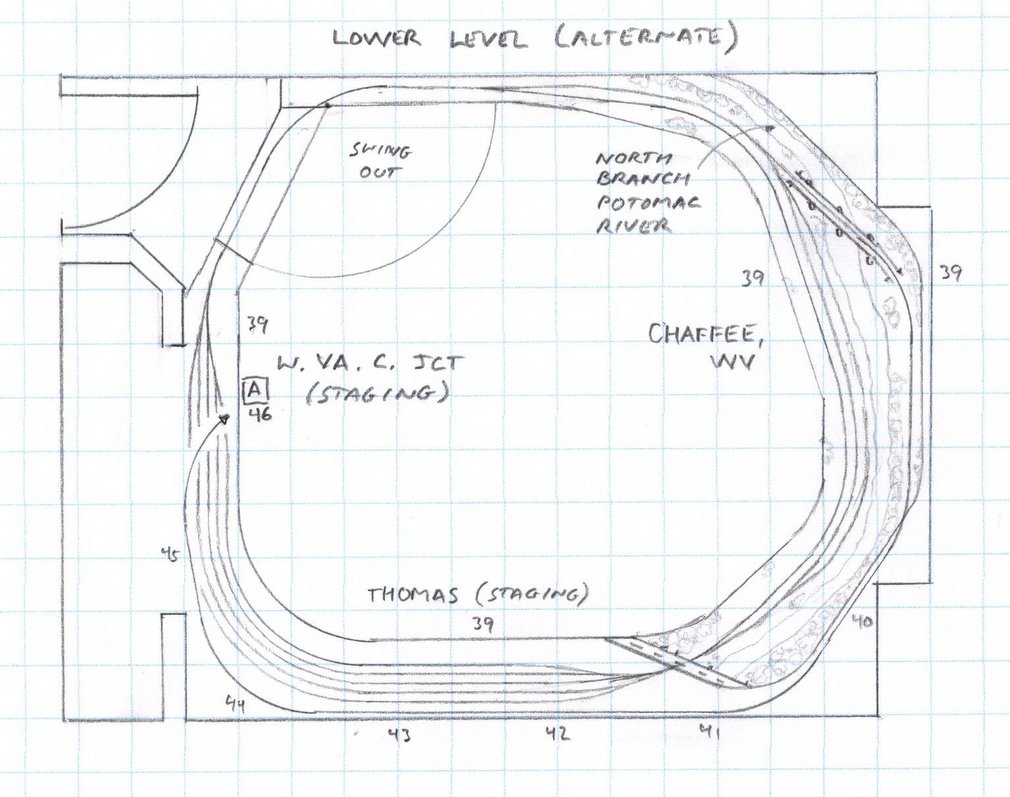- Size: 12′ x 16′
- Scale: HO
- Minimum Radius: 27″
- Minimum Aisle Width: 30″
- Designed by Dan Bourque
 The Western Maryland’s Chaffee Branch was an insane piece of railroad with grades so steep it took the second largest shay locomotive ever built to operate the branch. The WM’s shay No 6 is both the biggest on the WM and the last built by Lima in 1945. Operationally it only lasted for 5 years as the steepest parts of the Chaffee Branch for which it was built ceased operation in 1950 when the mine at Vindex, MD closed. Thankfully, this shay was preserved and is now operated by the Cass Scenic Railway. The Chaffee Branch, part of the WM’s coal producing Thomas Sub, begs to be modeled with its steep grades, shay operations, and operational challenges like a switchback with a short tail track.
The Western Maryland’s Chaffee Branch was an insane piece of railroad with grades so steep it took the second largest shay locomotive ever built to operate the branch. The WM’s shay No 6 is both the biggest on the WM and the last built by Lima in 1945. Operationally it only lasted for 5 years as the steepest parts of the Chaffee Branch for which it was built ceased operation in 1950 when the mine at Vindex, MD closed. Thankfully, this shay was preserved and is now operated by the Cass Scenic Railway. The Chaffee Branch, part of the WM’s coal producing Thomas Sub, begs to be modeled with its steep grades, shay operations, and operational challenges like a switchback with a short tail track.
The Layout
This layout, designed for a medium sized bedroom with closet, captures every switch of the Chaffee Branch as it appeared in its later years. The branch departed from the Thomas Sub at Chaffee, WV, crossed the North Branch Potomac River into Maryland, and climbed steeply up Three Forks Run. The branch was home to two loaders, the small Garrett Coal Company tipple between Chaffee and Vindex, and the large Vindex Mine No 3 at the end of the line reached via a switchback. The grade between Chaffee and Vindex exceeded 3% for all but the first 1/3 of a mile, and it topped out at 6.9% approaching Vindex. From Vindex to Mine No 3, the grade averaged around 6.5% with a short section reaching 9.1%. The grade at the tipple exceeded 6%. Needless to say, these grades figure heavily into this plan!
The layout starts at Chaffee where a long and short siding are modeled alongside the main and the Potomac. This siding was where the WM shay would pick up empties and drop off loads for the branch, so while the mainline is not operational, the scene figures prominently into the operations. After crossing the Potomac, the Chaffee Branch climbs hidden behind a steep hillside until it pops out at Garrett Tipple, the start of the upper level. I’ve used a wooden footbridge here (not prototypical) to hide the transition through the backdrop. From here, the line climbs at about 3.5% to Vindex where it enters a prototypically short tail track. The track diagram shows a spur off the tail track, and there is a slightly larger building along the tracks here in aerial photos. While I can’t confirm its accuracy, I’ve taken the liberty to add a small engine house and water tank here. Of note, I’ve recessed the tipple at Garrett to allow access (albeit a squeeze) to the engine house. The shay didn’t leave this Branch very often, so it had to have some sort of facilities to maintain and service it–this seemed like the logical spot. From Vindex, the line climbs steeply toward the mine, starting around 3.5% and hitting a brief section of 9% before settling into about a 5.5% grade (1″ every 18″) which it carries through the end of the tracks at a height of 69″ above the floor–that represents a climb of nearly 30″ on a bedroom-sized layout without a helix! The tipple is modeled with all tracks, including a run-away track (very important here).
The lower level in the original plan is designed for someone who wants to focus on the branch and avoid complicated track and benchwork, but here’s an alternative lower level for those who wish to model more of the mainline. The mainline here forms a continuous running loop with a five-track, double-ended staging yard to hold a handful of short trains (9-13′ long). A swing-out section alleviates the need for a full duck-under, but when stowed, the aisle between the wall and peninsula is cut to around 20″ (a lift-out section might eliminate this). A highway bridge hides the transition through the backdrop for the mainline, and the Chaffee Branch’s transition is hidden by tall trees along the bank of the river.
There wouldn’t need to be anything too fancy about construction of this layout. The toughest part would be stair-stepping the benchwork to climb with the tracks. A CRITICAL piece of information to know is how steep a grade the model shay can handle with a handful of cars (I’ve verified you can find brass models of shay No 6). Once this is determined, the maximum grade can be adjusted accordingly–it would be a terrible thing to build the layout only to find out the locomotive can’t run on it! The WM, at times it seems, had two shays working the branch, but it can easily be worked by one. With just a single locomotive, DC would be adequate. With two locomotives, DCC would make more sense. Either way, a walk-around throttle would be important for following the trains.
Operations
This layout is designed for 1-2 operators who like operating sloooooowly! Shay No 6’s top speed was about 20 MPH, but it ran far slower on the grades of this line, probably closer to 5 MPH. In theory, operations are simple. The layout is set up with around 30 empties in the siding at Chaffee, about 25 loads at Mine No 3, and about 5 loads at Garrett. The shay would start out at Vindex and work its way up to the tipple to grab its first set of loads, keeping the locomotive on the downhill side of any cars. The two sidings on both lines of the switchback would allow a train to haul more cars than it could fit into the tail track and just use a couple of moves to shuffle them from one line to the other. After enough runs to fill up the larger siding at Vindex, maybe 10 cars, the shay would head slowly downhill toward Chaffee, again, engine downhill to minimize the chance of couplers breaking and cars running away down the crazy grade.
At Chaffee, the shay would swap out loads for empties, just enough to fit into the Vindex siding. Working its way back uphill shoving the empties, the shay would have to reverse its process to move the empties onto the mine side of the switchback, shoving them in short cuts up the steep grade to the tipple. Spotting the empties in the stub tracks might take several moves to seesaw into all the tracks. Then comes the process of pulling down a few more empties and repeating this cycle until all the loads and empties have been swapped at both the mine and Garrett Tipple–around 4 total trips up and down the branch at 5 MPH along with some interesting switching moves on the way. At some point, the shay would need to stop by a tipple and grab some coal of its own as there’s no evidence of a coaling tower (a practice adopted by the Brimstone, another shay-operating coal hauler). A full ops session is likely to take a couple hours!
If you haven’t figured it out already, one critical part of operating this layout would be BRAKES on all the tracks! I’ve found a slide switch mounted vertically under the tracks with a .020″ music wire that pops up between the tracks to hold the axles works well–it can be activated by a metal shaft with a crank on the switch end and a lever on the fascia end. I see a need for about 15 brake locations on the layout.
For variety, a two-shay (touche?) session could be done with two operators. One could work from Vindex up to the mine, and the other could work between Vindex and Chaffee. It would make quicker work of things, but it would still take about 4 trips a piece. Again, if you like shays and sloooow, then this is a good layout for you! With the alternate lower level, both through trains (as many as you want to add by recycling through staging) and locals can add to the mix. The locals (probably two per session) would run one direction from staging, swap out empties for the loads at Chaffee, and head back into staging. Mainline trains could either be set to run in circles (no operator) to add some extra movement to the lower level, or an additional operator could run all the mainline trains in sequence. At a minimum, it would be a way to add variety to the session with early diesels and non-hopper cars rolling by.
Things I Like About This Plan:
- Prototypically wicked grades
- Tracks need to be used several times in a session
- Shays are cool!
- Fairly uncompressed
Things I Don’t Like About This Plan:
- No continuous running
- No mainline trains
- Could become repetitive
- Engine house squeezed in a hard-to-reach corner
Related Products:






Dan, I really like this theme and layout design. Again, you have approached the subject with your usual thoughtfulness and come up with a real gem of a track plan. There’s something about big Shays and short trains that I find quite appealing.
Please feel free to post a link on the RMR forum back to this plan and any other topics you post on ARM!
The branch did have two Shays assigned to it. One was the new Shay, No. 6. The other was a 150 ton four trucker, No. 5, I believe originally purchased by the Chesapeake & Ohio, and later operating on the Greenbriar, Cheat & Elk (what’s now Cass Scenic). This engine had a Cass style diamond stack on it from its logging days.
I think only one engine was used at a time–the four trucker was the only engine for some years, and the purchase of No. 6 was due to increasing reliability problems with No. 5, which remained as a backup. No. 5 didn’t make it into preservation.
Models of Class D-150s are available in brass:
https://www.brasstrains.com/Classic/Product/Detail/058209/HO-Brass-Model-Train-WMC-C-O-N-W-Gigantic-4-Truck-Shay
From Don’s Depot Photos, from the Western Maryland file–
“5 was built by Lima in April 26, 1910, #2248, as Chesapeake & Ohio 11. It was retired in December 1923 and sold as Greenbrier Cheat & Elk RR 14 in February 1924. It became West Virginia Pulp & Paper Co 14 in October 1928 and sold as WM 5 in June 1932, It was retired in September 1950 and scrapped in October 1954.”
http://donsdepot.donrossgroup.net/dr0100/misc287.jpg
No. 5, still with its diamond stack, at what looks like Hagerstown to me (the big hills around Ridgely aren’t visible).
https://wvhistoryonview.org/catalog/000516
Found some more pix of that brass D-150:
https://www.trainmaster.ch/ZY-093.htm
Thanks, David—great info and appreciate the links!